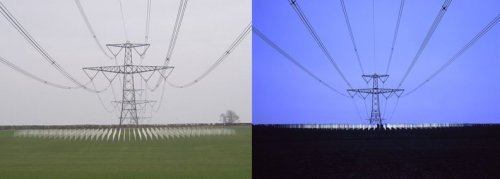 Maybe you saw the news story last August: Using images from Google Earth, Dr. Sabine Begall and her colleagues found that cows generally align themselves north-to-south, using the earth’s magnetic field as a guide. [ image source ]
Maybe you saw the news story last August: Using images from Google Earth, Dr. Sabine Begall and her colleagues found that cows generally align themselves north-to-south, using the earth’s magnetic field as a guide. [ image source ]
And you may have heard the followup story this week: Cows grazing around power lines faced in random directions because the electromagnetic fields generated by the power lines disrupted the cows’ internal sensors.
I was curious. If cows can have their internal systems messed with by power lines, what about plants? I did a quick web trawl and found all sorts of evidence that electromagnetic fields could in fact effect plant growth, though bioelectromagnetics is a field that hasn’t seen a huge amount of research.
One study “showed significantly greater wet root weight and significantly smaller stem diameter and dry seed weight at the end of the experiment in exposed plants compared to control plants.”
And I ran across an email response by Shireef Darwish, a grad student at the Department of Plant Science at McGill University, to the question “do magnetic fields have an effect on plant growth?” The explanation is worth reading, and includes an extensive bibliography that points to further effects of electromagnetism on plants.
 Outofdoors recently did a great post that reminded us that it would make so much more sense to generate power with solar cells at the point of use in the city than to deploy solar arrays in the desert, destroying big swaths of fragile desert.
Outofdoors recently did a great post that reminded us that it would make so much more sense to generate power with solar cells at the point of use in the city than to deploy solar arrays in the desert, destroying big swaths of fragile desert.
In addition to eating up the desert, I’d add that remote generation would require the power companies to deliver the power to distant cities, most likely over high tension lines. All of you can probably speak from personal experience that the power line roads that the electric companies gouge through the landscape beneath the lines do plenty to disfigure the landscape and to provide fertile open space that might encourage invasive species. Not a pretty sight. And then there’s the issue of the electromagnetic fields.
It’s been known for a while that a fluorescent tube placed underneath high-tension lines would glow just from the fields. (The effect is observable underneath the lines that carry the hugest amount of current, not necessarily the lower-capacity transmission lines.) There are at least two art projects that take advantage of this phenomenon, both to power the bulbs and to get us thinking about what it might mean for us to have these power lines in our midst.
 Larry and Debby Kline. Encryption (The Electric Fields of California, Site # 4) Sears Point Farming Company
Larry and Debby Kline. Encryption (The Electric Fields of California, Site # 4) Sears Point Farming Company
Tubbs Island, Sonoma, CA [ source ]
I met Larry and Debby Kline here in San Diego during 2003 when they had an opening of their artwork at a gallery across the street from a gallery where I was showing my own work. They were part of the way through this project where they made sculptures of fluorescent tubes beneath some of the high-capacity power lines that run through California. One project used 30 bulbs, another 60. (A tip from the Klines: The bulbs light up best when they’re standing on end.) After assembling the sculptures, they made striking photographs of them.
And then, in 2004, British artist Richard Box used 1301 bulbs in this installation.
 [ source ]
[ source ]
I don’t want to get all hysterical over the potential effects of these electromagnetic fields, but they obviously have some effects on animals and plants. While the power lines may be no more dangerous to your health than your cell phone or microwave oven, I can’t help but think that this is yet another poorly-designed and unnecessary science experiment that we humans have dropped into the landscape. There’s no doubt, though, that at least the power line roads have their impacts.
